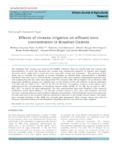Por favor, use este identificador para citar o enlazar este ítem:
http://www.alice.cnptia.embrapa.br/alice/handle/doc/978484Registro completo de metadatos
| Campo DC | Valor | Lengua/Idioma |
|---|---|---|
| dc.contributor.author | SILVA, M. A. S. da | pt_BR |
| dc.contributor.author | KLIEMANN, H. J. | pt_BR |
| dc.contributor.author | DE-CAMPOS, A. B. | pt_BR |
| dc.contributor.author | MADARI, B. E. | pt_BR |
| dc.contributor.author | BORGES, J. D. | pt_BR |
| dc.contributor.author | GONÇALVES, J. M. | pt_BR |
| dc.date.accessioned | 2017-07-19T23:49:21Z | - |
| dc.date.available | 2017-07-19T23:49:21Z | - |
| dc.date.created | 2014-02-04 | pt_BR |
| dc.date.issued | 2013 | pt_BR |
| dc.identifier.citation | African Journal of Agricultural Research, v. 8, n. 45, p. 5663-5671, Nov. 2013. | pt_BR |
| dc.identifier.issn | 1991-637X | pt_BR |
| dc.identifier.uri | http://www.alice.cnptia.embrapa.br/alice/handle/doc/978484 | pt_BR |
| dc.description | The irrigation with vinasse can improve soil fertility. However, this use should take into account the characteristics of each soil because the vinasse has unbalanced amounts of mineral and organic elements which might lead to leach the ions, especially nitrate and potassium. The purpose of this study was to evaluate the impacts of vinasse irrigation on effluent ionic concentrations in Brazilian Ferralsols from two areas in Central Brazil: a sugarcane field, and a natural undisturbed savannah area. Soil samples from the two sites were placed into PVC columns with 120 cm height × 25 cm diameter with sugarcane. Undiluted vinasse was applied once on the surface of the soil columns at doses equivalent to 0, 300, 600 and 1200 m3 ha-1. After 0, 60, 90 and 120 days of irrigation, samples of the effluent were collected and the concentrations of dissolved organic matter (DOM), Cl, Ca, Mg, Na, K, total Fe, NH4 +, NO3 -, SO4 2- as well as pH were determined. The ions concentration data were modeled in the chemical equilibrium model Visual Minteq v. 3.0. Results revealed vinasse?s dose, days after irrigation and land use had a relevant effect on most nutrients effluent concentration. Contrasting pH values were observed for both soils and in the savannah soil was observed a decrease in pH at high vinasse doses. This paper thus revealed leaching of the DOM was strongly time dependent. High vinasse doses may lead to increase nutrient leaching and soil dispersion regardless the land use and time after irrigation. | pt_BR |
| dc.language.iso | eng | eng |
| dc.rights | openAccess | eng |
| dc.title | Effects of vinasse irrigation on effluent ionic concentration in Brazilian Oxisols. | pt_BR |
| dc.type | Artigo de periódico | pt_BR |
| dc.date.updated | 2017-07-19T23:49:21Z | pt_BR |
| dc.subject.thesagro | Cana de açúcar | pt_BR |
| dc.subject.thesagro | Irrigação | pt_BR |
| dc.subject.thesagro | Lixiviação | pt_BR |
| dc.subject.thesagro | Etanol | pt_BR |
| dc.subject.thesagro | Cerrado | pt_BR |
| dc.subject.nalthesaurus | Leaching | pt_BR |
| dc.subject.nalthesaurus | Sugarcane | pt_BR |
| dc.subject.nalthesaurus | Ethanol | pt_BR |
| riaa.ainfo.id | 978484 | pt_BR |
| riaa.ainfo.lastupdate | 2017-07-19 | pt_BR |
| dc.identifier.doi | 10.5897/AJAR12.1441 | pt_BR |
| dc.contributor.institution | MELLISSA ANANIAS SOLER DA SILVA, CNPAF; HUBERTO JOSÉ KLIEMANN, UFG; ALFREDO BORGES DE-CAMPOS, UFG; BEATA EMOKE MADARI, CNPAF; JÁCOMO DIVINO BORGES, UFG; JANINE MESQUITA GONÇALVES, UFG. | pt_BR |
| Aparece en las colecciones: | Artigo em periódico indexado (CNPAF)  | |
Ficheros en este ítem:
| Fichero | Descripción | Tamaño | Formato | |
|---|---|---|---|---|
| effects.pdf | 1,12 MB | Adobe PDF |  Visualizar/Abrir |









